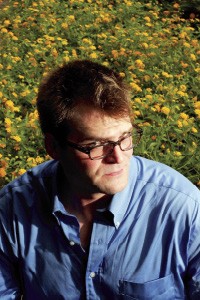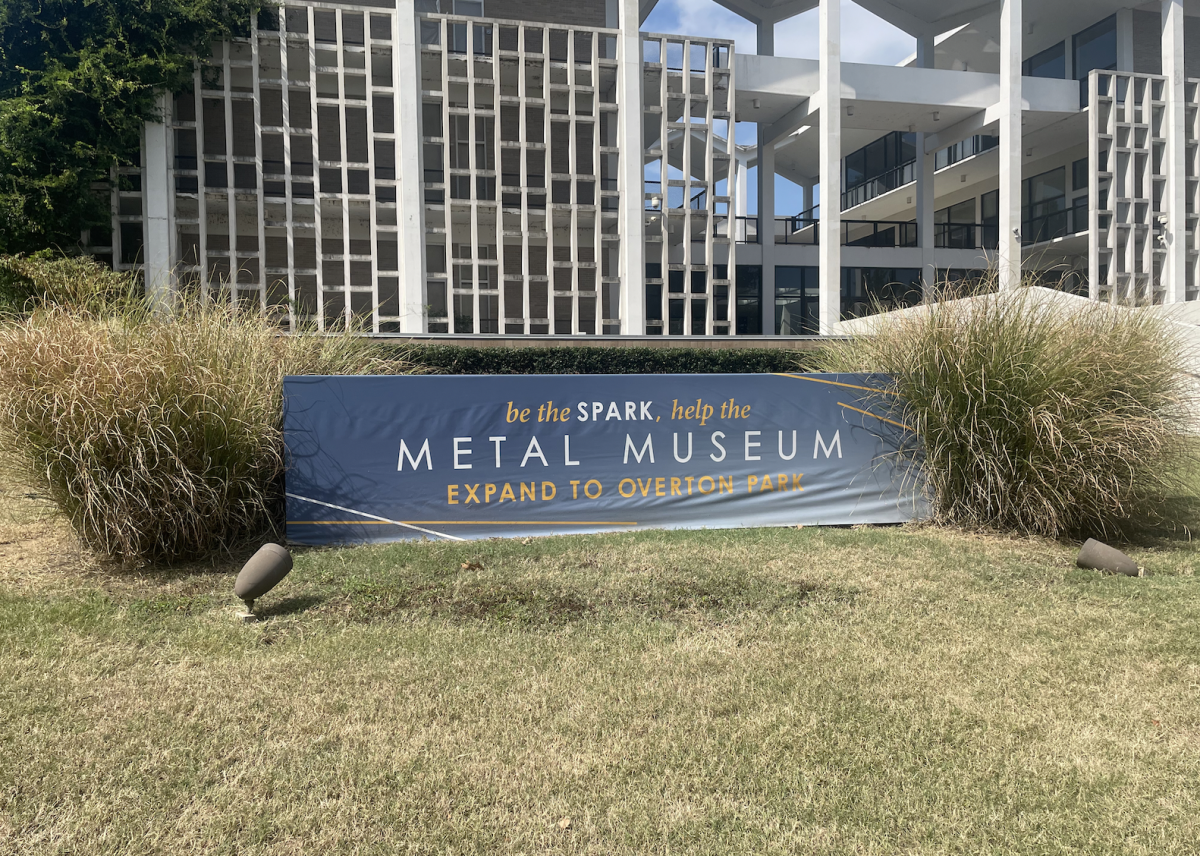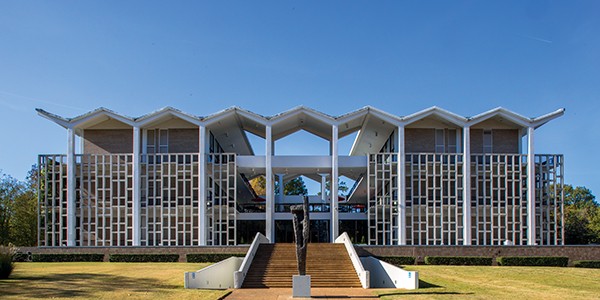In December, Carissa Hussong, founding executive director of Memphis’ UrbanArt Commission, left the organization she helped create to become executive director of the National Ornamental Metal Museum. She’s been replaced by John Weeden, a lanky, bespectacled Memphis native and Rhodes College graduate, with a pair of art-related master’s degrees from Sotheby’s in London and New York’s Bard College.
In its 10-year existence, the UrbanArt Commission, a not-for-profit organization dedicated to the development and implementation of public art, has stirred up its share of controversy. It also has had a measurable impact on the Bluff City’s physical identity by creating such major public artworks as the Cooper-Young trestle project and the epically conceived sculpture group that greets visitors to the Benjamin L. Hooks Central Library.
Weeden, who most recently worked as assistant director of the Rhodes College Center for Outreach in the Development of the Arts, is astonished by how much the commission has accomplished in a decade. But he’s convinced that the surface has barely been scratched. The Flyer recently talked to Weeden about UrbanArt and the state of public art in Memphis.
Flyer: You’ve noted that there weren’t many art jobs available in Memphis when you returned from Europe, where you were having some success as a curator. What inspired you to come back?
John Weeden: I was in Europe, living my dream. I was a curator working with contemporary artists from around the world. That’s what I worked my butt off for and dragged myself through two graduate programs to get to. But a couple of factors influenced my decision to return to Memphis: My father had some health issues while I was abroad. Thankfully, that’s no longer a motivating factor. But also, while I was overseas dealing with artists in a professional capacity, I noticed this trend: Nomadism was in vogue. Everybody seemed motivated by a sense of dislocation, because they didn’t identify with any one place or any particular culture. It boggled my mind that these people didn’t connect with anybody else, or any place or culture. That was when it occurred to me that I have a connection to a place and to a culture and to a group of people who love me and care about me. And that place is Memphis. I value that. You can call anyplace home, but you have to work for it. If you don’t work for it, you’ll always be dislocated.
Carissa Hussong put so much of herself into the UrbanArt Commission and took some grief as its public face. Are there pitfalls — or advantages — to being the second person to hold the position?
Carissa devoted herself to it, and sometimes she got a lot of flack for learning how to do things, because she was the first person to try and do this here. She deserves all the kudos in the world, because when nothing’s been done before, there’s a steep learning curve. Some things will work, some will work only halfway, and some will leave you saying, “Damn, I wish I hadn’t done that.”
Luckily for me, she’s run interference and done a lot of the heavy lifting. Now we’ve got to maintain relationships that have already been built. But also we must identify what can be done differently and better. And what’s been done perhaps unsuccessfully in the past. It’s taken the organization 10 years to build a firm foundation for how the commission completes its work. And there are areas in terms of community building that have not been done that successfully.
Where have things gone wrong?
Well, UrbanArt is a very small organization. It’s just two full-time staff people and me and an administrative assistant who comes in two days a week. So, when you’ve got 30 or more projects going on at one time, the project-management side of that alone evaporates all of your available outreach possibilities. Luckily, now we’ve gotten the project-management process down pretty well. We know how to complete things. Elizabeth Alley is the director of public art. Laura Caroline Johnson, the project coordinator, has been training under Elizabeth to do much the same kind of work. My job will include overseeing the projects but not the day-to-day nuts and bolts.
I want Memphis to understand that this is an organization that works for everyone. I want to help communities understand that they can engender their own projects. They can have an active voice in determining not only what their neighborhood looks like but what it says in terms of identity. We’re here to make landmarks. We’re here to “build home” through art and design.
It must help having grown up here.
It’s a big advantage that I grew up here and have a pretty good idea how people think and what their values are, aesthetically and communitywise. My motivation in any project is going to be based on what the community wants to do. Without community ownership and without the belief that these projects matter to the community — that they represent something the community aspires to be — ultimately the organization isn’t going to do very well.
 Justin Fox Burks
Justin Fox Burks
Not everything will be community-generated, will it?
Some of these ideas and artists will come from other places. There is a balance that you have to strike — between community-invented and -originated projects that express what the community wants to be and international cutting-edge design. There’s no reason it all should be one or the other. These ideas can work together in concert and inform each other.
Any prime examples of what the city has done right and wrong, design-wise?
Certain areas get it exactly right in stretches, then a few blocks away it all falls apart. South Main is a prominent example of some great neighborhood development over the past several years. When I was in high school, you didn’t go down there unless you wanted to get into trouble and get robbed. When I turned 16 and got my driver’s license, my parents told me, “You can go anywhere in the city but downtown.”
 Justin Fox Burks
Justin Fox Burks
John Weeden By Design: UrbanArt’s supergraphics along South Main at Central Station
That’s changed because of the efforts of the Center City Commission, UrbanArt, the South Main Association, Power House, the Civil Rights Museum, Delta Axis, and all these other organizations combining their resources, ingenuity, and ideas to work on this space — to say, “If we do this with purpose, something can really happen here.” But if it’s going to be an arts district in the long-term, more things have to happen. There has to be affordable housing for artists, actors, filmmakers, and so on. It would behoove the city and those who care about this issue to work with developers and take that next step.
Is that something UrbanArt can do anything about?
Not directly, but it’s all related. Art is one component of building these creative public spaces that lead to connecting people to a spot. They care more about what happens. They look after it; they look after their neighbors. They look after their home more.
Once you have that connectedness, you have a community. And art in public places is a key component to urban planning. So, when I talk about having art in public places, I’m not talking about plopping something down somewhere and then stepping back and saying, “Wow, it’s pretty now!” I’m about looking at the support structure underneath it: How do you arrive at having that art installed there?
There are a lot of people who have been working very hard behind the scenes for a lot of years to arrive at this very moment. And it feels like there’s a lot of pregnant material here.
If we take these next steps in concert and full awareness of what everybody else is doing, then we can be more productive. UrbanArt needs to be a part of that conversation, because it can help to structure what the end result looks like.
Memphis has its share of blighted areas and lots of disposable strip-mall culture. Can public art reverse these trends, or is it just ornament?
I’m sure a lot of these trends can be reversed, but you’d have to go at it in a rather drastic, wholesale way. Otherwise, you’re just putting on trimmings and making things cutesy. And cutesy is not what we want.
We want to be a real town with a recognizable identity, voice, and character that we can project to the rest of the world. The world already knows Memphis for its music and its literature, but I want Memphis to be known as an art town. And it can be. That’s not to say I can help every artist in town get on the art map.
There are a lot of misconceptions regarding UrbanArt’s funding structure. Every time a new project starts, there’s grumbling about wasted tax dollars. Why does that happen over and over again?
UrbanArt has not always accomplished good public awareness. There are people in this town who don’t know it exists. Or if they know it exists, they don’t know what it was designed to be or what it is now. And then they wildly misassume the funding structure. People think it’s a government body. It’s not. It’s a 501(c)(3) that gets partial funding from the city as a subcontractor.
The fractions of pennies paid for every year by tax dollars is probably getting the best payback of any investment you can make — at least, if you’re comparing price to result — because we only get 48 percent or less of our operating budget from the city. That figure for this year is about $130,000 to cover the salaries of four people, rent, and the MLGW bill. That’s what the tax dollars are going for. That’s half a drop in a giant bucket. And with that, we build more dynamic landscapes and landmark spaces, and we build better relationships between neighbors through creative practice.
Where does the rest of UrbanArt’s money come from?
The rest we have to source through the Tennessee Arts Council and Arts Memphis. And nobody’s paying taxes to Arts Memphis; they raise their own money.
What do you say to people who think public-art projects are frivolous?
Art will always be a punching bag to someone who doesn’t agree with it. It doesn’t matter if it’s art, music, theater. Art’s a sitting duck because so many people feel like its extraneous or elitist or whatever.
But think about an art project in Binghampton, where kids are learning to use digital cameras for the first time. Then it’s not extraneous. There’s a creative and constructive outlet, rather than a destructive one. For those kids, it’s not elitist. It’s bread and butter and “thank God I found this because my world is opening up and I’ve got another possibility to do something better with my life.”
Those are the kinds of projects I want people to know about, and those are the kinds of projects I want to do more of. I want to get the power of art — art making, art producing, and art conversations — into communities.
If you build these communities of art producers, not just passersby or consumers, it’s going to catch fire — in a good way.
Iron Maiden
Carissa Hussong trades UrbanArt for heavy metal.
“I guess I’m in that classic ‘bound to fail’ position,” jokes Carissa Hussong, former head of the UrbanArt Commission.
She’s sitting in the quaintly cluttered second-floor office of the National Ornamental Metal Museum, where she now serves as executive director. Like everyone who’s ever encountered her larger-than-life-size predecessor, Jim “Wally” Wallace, the master metalsmith who founded the enduring south bluff museum, she’s a little overwhelmed. And although she readily admits to having no original ideas yet for leaving her mark on the facility, she has no intention of failing either.
“When I first took this job, everybody would come up to me and say, ‘Tell me all about the Metal Museum.’ ‘What’s your vision?’ ‘What is it that you want to do?’ And I didn’t know what I should tell them. I didn’t know if what I was thinking about doing was in keeping with the things that really needed to be done. And I didn’t want to say a bunch of things just to say them.
“I don’t think I have a huge vision,” Hussong admits, running down a list of changes that range from making the facility more handicap-accessible to growing the museum’s artist-in-residency program. “Everything I’ve put down on paper has either come from suggestions made by staff and board members or from things I’ve found in previous business plans.
“It’s not about coming in here and developing a lot of new programs. It’s about taking existing programs to the next level,” Hussong asserts, allowing that the museum’s needs are somewhat paradoxical.
Although the facility is located on the southern edge of downtown, the Metal Museum is a quiet, introspective place, where visitors can discover the wonders of traditional metal-working or just get away from it all to watch the river roll by.
“Whatever we do, I don’t want to lose that sense that when you come here you are coming to a very special place. Of course, we want more people to know about it, and we want them to come. But it’s not grow, grow, grow. We have to grow carefully and wisely and strategically.
“Most people don’t even know we have an artist-in-residency program,” Hussong says, setting up a smart-growth example. “I think we’ll have a waiting list for that program, once people know about it.”
Why did Hussong leave UrbanArt after 10 years?
“I was ready for a change,” she says. “It may seem like there’s a lot of turnover right now,” she adds, noting that the Dixon Gallery and Gardens also has a new director and that the Brooks Museum is casting about to fill its top slot. “But usually there aren’t a lot of opportunities for these kinds of jobs in the Memphis art world.
“After a while, my job [at UrbanArt] stopped being about art,” she says. “It was more about construction and about the whole committee process. And that just wasn’t what I wanted the rest of my career to be about.”
There were other issues that drove Hussong to look for another position. She was plagued by speculation that her job created a conflict of interest, because her husband, David Lusk of David Lusk Gallery, represents a substantial group of regional artists.
“I was always so careful about that perception — to the detriment of his artists,” Hussong says. “Because if anybody really suffered, it was the artists he represented. I just couldn’t promote them. So it was the right time for me to move on. And it was the right time for the organization as well.”
Hussong describes her new position as “everything I’d done, combined into one position,” pointing out that she will continue to be involved in the creation of public artwork, only this time as a contractor.

 Photographs by Justin Fox Burks
Photographs by Justin Fox Burks  Metal Museum/Facebook
Metal Museum/Facebook 
 Justin Fox Burks
Justin Fox Burks  Justin Fox Burks
Justin Fox Burks